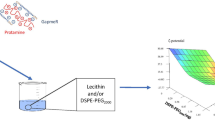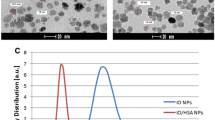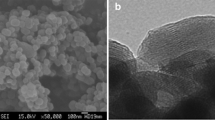Abstract
The biocompatibility of cationic liposomes has led to their clinical translation in gene delivery and their application apart from cancer to cardiovascular diseases, osteoporosis, metabolic diseases, and more. We have prepared PEGylated stearyl amine (pegSA) lipoplexes meticulously considering the physicochemical properties and formulation parameters to prepare single unilamellar vesicles (SUV) of < 100 nm size which retain their SUV nature upon complexation with pDNA rather than the conventional lipoplexes which show multilamellar nature. The developed PEGylated SA lipoplexes (pegSA lipoplexes) showed a lower N/P ratio (1.5) for BMP-9 gene complexation while maintaining the SUV character with a unique shape (square and triangular lipoplexes). Colloidal and pDNA complexation stability in the presence of electrolytes and serum indicates the suitability for intravenous administration for delivery of lipoplexes to bone marrow mesenchymal stem cells through sinusoidal vessels in bone marrow. Moreover, lower charge density of lipoplexes and low oxidative stress led to lower toxicity of lipoplexes to the C2C12 cells, NIH 3T3 cells, and erythrocytes. Transfection studies showed efficient gene delivery to C2C12 cells inducing osteogenic differentiation through BMP-9 expression as shown by enhanced calcium deposition in vitro, proving the potential of lipoplexes for bone regeneration. In vivo acute toxicity studies further demonstrated safety of the developed lipoplexes. Developed pegSA lipoplexes show potential for further in vivo preclinical evaluation to establish the proof of concept.







Similar content being viewed by others
References
Balazs DA, Godbey W. Liposomes for use in gene delivery. J Drug Deliv. 2011;2011:1–12.
Simoes S, Filipe A, Faneca H, Mano M, Penacho N, Duzgunes N, et al. Cationic liposomes for gene delivery. Expert Opin Drug Deliv. 2005;2(2):237–54.
Vhora I, Patil S, Amrutiya J, Misra A. Liposomes and lipid envelope-type systems for systemic siRNA delivery. Curr Pharm Des. 2015;21(31):4541–55.
Kang Q, Sun MH, Cheng H, Peng Y, Montag AG, Deyrup AT, et al. Characterization of the distinct orthotopic bone-forming activity of 14 BMPs using recombinant adenovirus-mediated gene delivery. Gene Ther. 2004;11(17):1312–20.
Tavassoli M. Structure and function of sinusoidal endothelium of bone marrow. Prog Clin Biol Res. 1981;59B:249–56.
Lakshmipathy U, Pelacho B, Sudo K, Linehan JL, Coucouvanis E, Kaufman DS, et al. Efficient transfection of embryonic and adult stem cells. Stem Cells. 2004;22(4):531–43.
Wang D, Jing N-h, Lin Q-s. Stearylamine liposome as a new efficient reagent for DNA transfection of eukaryotic cells. Biochem Biophys Res Commun. 1996;226(2):450–5.
Zou Y, Zong G, Yi-He L, Perez-Soler R. Development of cationic liposome formulations for intratracheal gene therapy of early lung cancer. Cancer Gene Ther. 2000;7(5):683–96.
Yoshihara E, Nakae T. Cytolytic activity of liposomes containing stearylamine. Biochim Biophys Acta Biomembr. 1986;854(1):93–101.
Fàbregas A, Prieto-Sánchez S, Suñé-Pou M, Boyero-Corral S, Ticó JR, García-Montoya E, et al. Improved formulation of cationic solid lipid nanoparticles displays cellular uptake and biological activity of nucleic acids. Int J Pharm. 2017;516(1):39–44.
Carrillo C, Sánchez-Hernández N, García-Montoya E, Pérez-Lozano P, Suñé-Negre JM, Ticó JR, et al. DNA delivery via cationic solid lipid nanoparticles (SLNs). Eur J Pharm Sci. 2013;49(2):157–65.
Silva AL, Alexandrino F, Verissimo LM, Agnez-Lima LF, Egito LC, de Oliveira AG, et al. Physical factors affecting plasmid DNA compaction in stearylamine-containing nanoemulsions intended for gene delivery. Pharmaceuticals (Basel). 2012;5(6):643–54.
Israelachvili JN, Mitchell DJ. A model for the packing of lipids in bilayer membranes. Biochim Biophys Acta. 1975;389(1):13–9.
Israelachvili JN, Mitchell DJ, Ninham BW. Theory of self-assembly of lipid bilayers and vesicles. Biochim Biophys Acta. 1977;470(2):185–201.
Casals E, Soler M, Gallardo M, Estelrich J. Electrophoretic behavior of stearylamine-containing liposomes. Langmuir. 1998;14(26):7522–6.
Van’t Hag L, Gras SL, Conn CE, Drummond CJ. Lyotropic liquid crystal engineering moving beyond binary compositional space—ordered nanostructured amphiphile self-assembly materials by design. Chem Soc Rev. 2017;46(10):2705–31.
Lonez C, Vandenbranden M, Ruysschaert J-M. Cationic lipids activate intracellular signaling pathways. Adv Drug Deliv Rev. 2012;64(15):1749–58.
Khatri N, Baradia D, Vhora I, Rathi M, Misra A. Development and characterization of siRNA lipoplexes: effect of different lipids, in vitro evaluation in cancerous cell lines and in vivo toxicity study. AAPS PharmSciTech. 2014;15(6):1630–43.
Patel J, Amrutiya J, Bhatt P, Javia A, Jain M, Misra A. Targeted delivery of monoclonal antibody conjugated docetaxel loaded PLGA nanoparticles into EGFR overexpressed lung tumour cells. J Microencapsul. 2018;35(2):204–17.
Patil S, Bhatt P, Lalani R, Amrutiya J, Vhora I, Kolte A, et al. Low molecular weight chitosan–protamine conjugate for siRNA delivery with enhanced stability and transfection efficiency. RSC Adv. 2016;6(112):110951–63.
Vhora I, Khatri N, Desai J, Thakkar HP. Caprylate-conjugated cisplatin for the development of novel liposomal formulation. AAPS PharmSciTech. 2014;15(4):845–57.
Bhatt P, Khatri N, Kumar M, Baradia D, Misra A. Microbeads mediated oral plasmid DNA delivery using polymethacrylate vectors: an effectual groundwork for colorectal cancer. Drug Deliv. 2015;22(6):849–61.
Bhatt P, Lalani R, Vhora I, Patil S, Amrutiya J, Misra A, et al. Liposomes encapsulating native and cyclodextrin enclosed paclitaxel: enhanced loading efficiency and its pharmacokinetic evaluation. Int J Pharm. 2018;536(1):95–107.
Yewale C, Baradia D, Patil S, Bhatt P, Amrutiya J, Gandhi R, et al. Docetaxel loaded immunonanoparticles delivery in EGFR overexpressed breast carcinoma cells. J Drug Deliv Sci Tec. 2018;45:334–45.
Campbell PI. Toxicity of some charged lipids used in liposome preparations. Cytobios. 1983;37(145):21–6.
Mayhew E, Ito M, Lazo R. Toxicity of non-drug-containing liposomes for cultured human cells. Exp Cell Res. 1987;171(1):195–202.
Israelachvili J. The science and applications of emulsions—an overview. Colloids Surf A Physicochem Eng Asp. 1994;91:1–8.
Dos Santos N, Allen C, Doppen A-M, Anantha M, Cox KAK, Gallagher RC, et al. Influence of poly(ethylene glycol) grafting density and polymer length on liposomes: relating plasma circulation lifetimes to protein binding. Biochim Biophys Acta Biomembr. 2007;1768(6):1367–77.
Tandia B-M, Vandenbranden M, Wattiez R, Lakhdar Z, Ruysschaert J-M, Elouahabi A. Identification of human plasma proteins that bind to cationic lipid/DNA complex and analysis of their effects on transfection efficiency: implications for intravenous gene transfer. Mol Ther. 2003;8(2):264–73.
Weisman S, Hirsch-Lerner D, Barenholz Y, Talmon Y. Nanostructure of cationic lipid-oligonucleotide complexes. Biophys J. 2004;87(1):609–14.
Bell PC, Bergsma M, Dolbnya IP, Bras W, Stuart MC, Rowan AE, et al. Transfection mediated by gemini surfactants: engineered escape from the endosomal compartment. J Am Chem Soc. 2003;125(6):1551–8.
Radler JO, Koltover I, Salditt T, Safinya CR. Structure of DNA-cationic liposome complexes: DNA intercalation in multilamellar membranes in distinct interhelical packing regimes. Science (New York, NY). 1997;275(5301):810–4.
Simberg D, Danino D, Talmon Y, Minsky A, Ferrari ME, Wheeler CJ, et al. Phase behavior, DNA ordering, and size instability of cationic lipoplexes relevance to optimal transfection activity. J Biol Chem. 2001;276(50):47453–9.
de la Torre LG, Rosada RS, Trombone AP, Frantz FG, Coelho-Castelo AA, Silva CL, et al. The synergy between structural stability and DNA-binding controls the antibody production in EPC/DOTAP/DOPE liposomes and DOTAP/DOPE lipoplexes. Colloids Surf B: Biointerfaces. 2009;73(2):175–84.
Silva JP, Oliveira AC, Lucio M, Gomes AC, Coutinho PJ, Oliveira ME. Tunable pDNA/DODAB:MO lipoplexes: the effect of incubation temperature on pDNA/DODAB:MO lipoplexes structure and transfection efficiency. Colloids Surf B: Biointerfaces. 2014;121:371–9.
Kolate A, Baradia D, Patil S, Vhora I, Kore G, Misra A. PEG—a versatile conjugating ligand for drugs and drug delivery systems. J Control Release. 2014;192:67–81.
Coburn RF. Polyamine effects on cell function: possible central role of plasma membrane PI(4,5)P2. J Cell Physiol. 2009;221(3):544–51.
Carmona-Ribeiro AM, Ortis F, Schumacher RI, Armelin MCS. Interactions between cationic vesicles and cultured mammalian cells. Langmuir. 1997;13(8):2215–8.
Dymond MK, Attard GS. Cationic type I amphiphiles as modulators of membrane curvature elastic stress in vivo. Langmuir. 2008;24(20):11743–51.
Lonez C, Vandenbranden M, Ruysschaert J-M. Cationic liposomal lipids: from gene carriers to cell signaling. Prog Lipid Res. 2008;47(5):340–7.
Lonez C, Lensink MF, Vandenbranden M, Ruysschaert J-M. Cationic lipids activate cellular cascades. Which receptors are involved? Biochim Biophys Acta Gen Subj. 2009;1790(6):425–30.
Chan C-L, Majzoub RN, Shirazi RS, Ewert KK, Chen Y-J, Liang KS, et al. Endosomal escape and transfection efficiency of PEGylated cationic lipid–DNA complexes prepared with an acid-labile PEG-lipid. Biomaterials. 2012;33(19):4928–35.
Ciani L, Ristori S, Salvati A, Calamai L, Martini G. DOTAP/DOPE and DC-Chol/DOPE lipoplexes for gene delivery: zeta potential measurements and electron spin resonance spectra. Biochim Biophys Acta Biomembr. 2004;1664(1):70–9.
Lamplot JD, Qin J, Nan G, Wang J, Liu X, Yin L, et al. BMP9 signaling in stem cell differentiation and osteogenesis. Am J Stem Cells. 2013;2(1):1–21.
Szoka FC, Xu Y, Zelphati O. How are nucleic acids released in cells from cationic lipid-nucleic acid complexes? J Liposome Res. 1996;6(3):567–87.
Sharff KA, Song W-X, Luo X, Tang N, Luo J, Chen J, et al. Hey1 basic helix-loop-helix protein plays an important role in mediating BMP9-induced osteogenic differentiation of mesenchymal progenitor cells. J Biol Chem. 2009;284(1):649–59.
Acknowledgements
The authors are thankful to the University Grants Commission, Government of India for financial assistance. The authors also thank Dr. Vikram Sarabhai Central Facility, The Maharaja Sayajirao University of Baroda, Vadodara, for experimental support in cell line studies. The authors acknowledge the support of Dr. Sachin Naik and Dr. Subhas Bhowmick (Sun Pharma Advance Research Center Ltd., Vadodara) for cryoTEM studies.
Author information
Authors and Affiliations
Corresponding author
Ethics declarations
Conflict of Interest
The authors declare that they have no conflict of interest.
Additional information
Guest Editors: Mahavir Bhupal Chougule, Vijaykumar B. Sutariya and Sudip K. Das
Rights and permissions
About this article
Cite this article
Vhora, I., Lalani, R., Bhatt, P. et al. Colloidally Stable Small Unilamellar Stearyl Amine Lipoplexes for Effective BMP-9 Gene Delivery to Stem Cells for Osteogenic Differentiation. AAPS PharmSciTech 19, 3550–3560 (2018). https://doi.org/10.1208/s12249-018-1161-6
Received:
Accepted:
Published:
Issue Date:
DOI: https://doi.org/10.1208/s12249-018-1161-6




